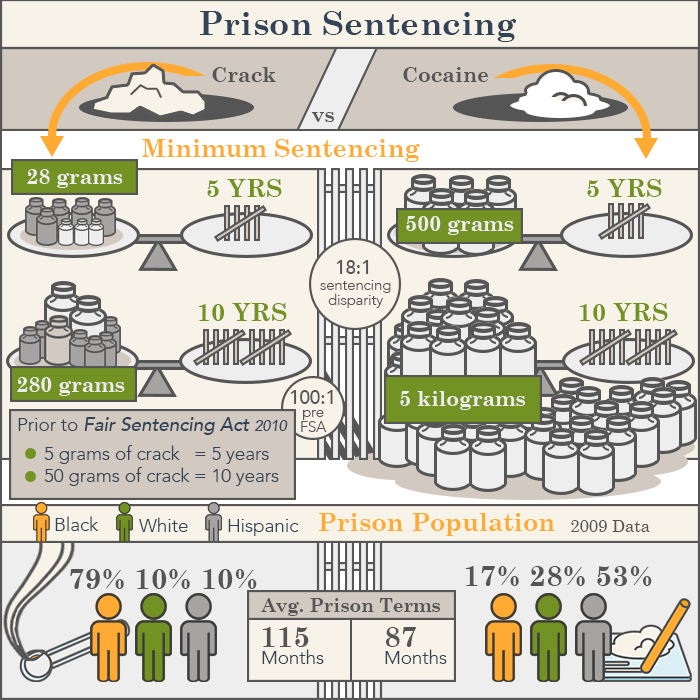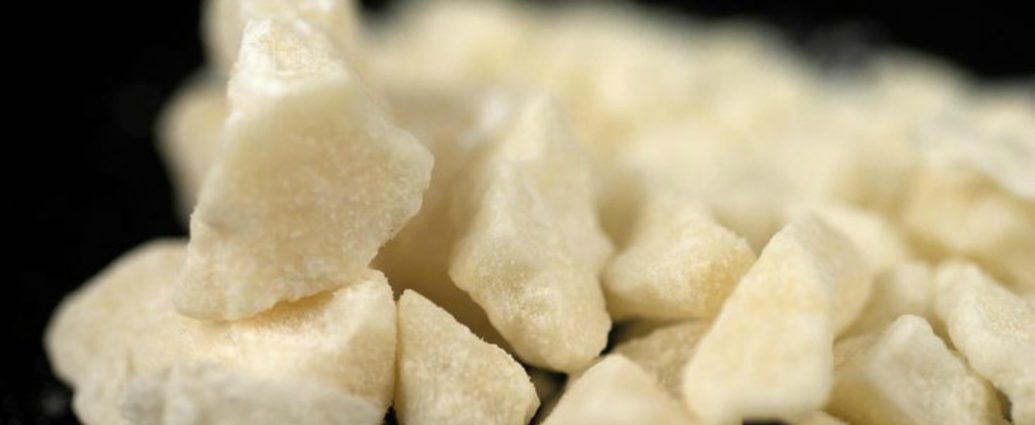WHAT IS CRACK COCAINE?
Crack cocaine is the crystal form of cocaine, which normally comes in a powder form.1 It comes in solid blocks or crystals varying in color from yellow to pale rose or white.
Crack is heated and smoked. It is so named because it makes a cracking or popping sound when heated.
Crack, the most potent form in which cocaine appears, is also the riskiest. It is between 75% and 100% pure, far stronger and more potent than regular cocaine.
Smoking crack allows it to reach the brain more quickly and thus brings an intense and immediate—but very short-lived—high that lasts about fifteen minutes. And because addiction can develop even more rapidly if the substance is smoked rather than snorted (taken in through the nose), an abuser can become addicted after his or her first time trying crack.
Because of cocaine’s high cost, it has long been considered a “rich man’s drug.” Crack, on the other hand, is sold at prices so low that even teens can afford to buy it—at first. The truth is that once a person is addicted, the expense skyrockets in direct ratio to the increasing amount needed to support the habit.
“I lived with a crack addict for nearly a year. I loved that addict, who was my boyfriend, with all my heart but I couldn’t stick [with] it anymore.
“The police stopped and searched me; we were raided at 6:00 A.M. My ex stole incessantly and couldn’t tear himself away from his pipe.
“I think crack is more evil than heroin—one pipe can be all it takes to turn you into an immoral monster.” —Audrey
What is Crack? Differences Between Crack and Cocaine?
Specifics of Cocaine and Crack
Cocaine is a hydrochloride salt in its powdered form, while crack cocaine is derived from powdered cocaine by combining it with water and another substance, usually baking soda (sodium bicarbonate). After cocaine and baking soda are combined, the mixture is boiled, and a solid forms. Once it’s cooled and broken into smaller pieces, these pieces are sold as crack.
The name crack derives from the crackling sound that is produced when the drug is heated and then smoked, according to the Center for Substance Abuse Research. Since crack is so highly concentrated, it is extremely addictive. While not common, it’s possible for a person to become addicted to crack after just one use.
Cocaine can have serious negative effects on the person abuse this drug. If you or a loved one is currently using cocaine or other addictive substances, help is only a phone call away. At American Addiction Centers (AAC) we can answer your questions about addiction and provide information about our treatment options. We’re here to help 24/7, give us a call today at 888-850-0321 .
Cocaine and crack certainly differ in appearance. Cocaine is generally found in white powder form, and crack is found in a rock form that is generally white, cream, tan, or light brown. Crack and cocaine also differ in the manner in which they are used. Cocaine is typically snorted, and crack is typically smoked.
Another difference between crack and cocaine relates to the high produced. The intensity and duration of the high largely relate to how the drug is taken, per the National Institute on Drug Abuse. Generally, when cocaine is injected or smoked, the drug takes effect more quickly, resulting in a more intense but shorter high. When cocaine is snorted, it takes longer to feel its effects but the resulting high lasts longer.
According to a clinical pharmacist, cocaine and crack produce very different effects in the body, largely related to how they are usually administered. When cocaine is snorted, its effects occur in about 1-5 minutes; they peak within 20-30 minutes; and they dissipate within 1-2 hours. The effects of crack take hold in under a minute, peak in 3-5 minutes, and last 30-60 minutes. If cocaine is injected, however, the effects begin, peak, and for about as long as crack. While injection is not the most common method of cocaine consumption, it is used by some people.
Who Uses Crack, and Who Uses Cocaine?

Cocaine is expensive to buy on the streets. Crack was developed as a cheaper alternative to cocaine, making it more easily affordable to users. As a less expensive alternative, it became more accessible to those in the lower socioeconomic demographic. These people had less disposable income available to spend on drugs, but they were seeking options to get high. This brought crack use to low-income and minority communities. By the 1980s, there was an epidemic of crack use in these communities.
As a result, there is a public perception that cocaine is associated with more affluent drug users, whereas crack use is associated with those in lower income brackets and minorities. Despite this widespread belief, information from the National Institute on Drug Abuse showed that in 1991, the majority of crack users were Caucasian.
Generally, those who want a more intense, faster, cheaper high are attracted to crack. Some people begin with cocaine use and then transition to crack use when the habit of cocaine use is too expensive to maintain. According to the National Study on Drug Use and Health, in 2008, there were 1.9 million cocaine users, of which 359,000 used crack.
Comparing Other Drugs
Effects and Risks of Crack vs. Cocaine Use
The effects of crack can be variable due to the uncertainty of the purity of the cocaine used to manufacture it. This only adds to the seriousness and unpredictability of smoking crack. The effects of crack use are similar to cocaine use although often more intense. They include:
- Euphoria
- Heightened alertness
- Dilated pupils
- Decreased appetite
- Increased heart rate
- Intense cravings
Smoking crack causes these effects to take hold more quickly and intensely than cocaine because crack is absorbed through the membranes of the lungs, entering the bloodstream and the brain within 10-15 seconds. As such, the risk of overdosing is extremely high, leading to convulsions, coma, and death. Symptoms of crack overdose are rapid heart rate and hyperventilation.
Long-term effects of crack use include mood changes, irritability, restlessness, depression, anxiety, paranoia, and hallucinations.
It is easy to develop a crack or cocaine abuse problem because the drug in both forms is highly addictive. As such, issues with withdrawal often arise. Symptoms of withdrawal include:
- Agitation
- Intense cravings
- Depression
- Anxiety
- Nausea
- Extreme fatigue
- Muscle pain
- Suicidal thoughts

Historical, Legal, and Criminal Disparity
Before 1986, federal laws treated crack and cocaine the same. News coverage during that time reported a crack epidemic, according to Newsweek, stating that crack was “the most addictive drug known to man.”The Anti-Drug Abuse Act of 1986 enacted a five-year minimum sentence for a first offense of possession of at least 5 grams of crack. The same law also required possession of at least 500 grams of cocaine to reach the same five-year minimum sentence. This began the so-called “ratio sentencing;” it took 100 times the amount of cocaine as crack to earn a mandatory minimum five-year sentence.
Passage of this act immediately resulted in the prosecution of many African American males who were caught with as little as 5 grams of crack. Since these men often resided in low-income neighborhoods, crack was more readily available due to its ease of production and low price.
African Americans became the criminal targets of the crack epidemic. Most defendants in crack trials were African American while those in powdered cocaine trials tended to be Caucasian or Hispanic. In 2002, African Americans represented more than 80 percent of those charged with crack offenses.
This created racial and social disparity in the legal process that endured until the passage of the Fair Sentencing Act of 2010, which eliminated the five-year mandatory minimum sentence and increased the amount of crack necessary to result in the minimum sentence.
The Act also changed the crack-to-powder-cocaine ratio regarding the amount required to impose an equal sentence from 100-to-1 to 18-to-1. While the disparity in sentencing is still great at 18:1, it is significantly reduced.
Resources Used
- http://www.drugpolicy.org/drug-facts/cocaine-and-crack-facts
- http://www.drugabuse.gov/publications/research-reports/cocaine/what-are-long-term-effects-cocaine-use
- https://www.nlm.nih.gov/medlineplus/ency/patientinstructions/000793.htm http://www.clarkprosecutor.org/html/substnce/crack.htm
- http://www.usnews.com/news/articles/2010/08/03/data-show-racial-disparity-in-crack-sentencing
- http://www.ussc.gov/report-cocaine-and-federal-sentencing-policy-1
- https://www.aclu.org/node/17576




